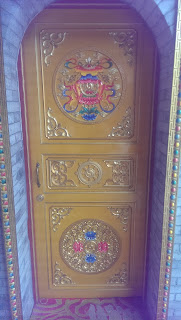Well, this last week has been ridiculously busy. I realize
that I talked of being really busy in Xi’an as well, but this was a much
different form of busy, which was, unfortunately, not a type of busy conducive
to writing a blog. So I apologize for my silence during until this point. I am
actually currently flying over the Pacific Ocean as I write this, scribbling in
the near dark on a notebook (Hainan Airlines doesn’t allow the use of phones or
computers at any time of the flight, a frustrating restriction on a ten hour
journey). Anyway, I suppose my study abroad experience has come to an end, and
as usual in these circumstances, it does feel as if it went by quickly, however
I am satisfied at what I was able to accomplish in such a time. Therefore I would
like to summarize my experience and how it has changed my current and future
outlooks.
To begin, I
believe I have attained a new appreciation for travel that I did not have
before. Prior to this study abroad trip, the longest I had stayed in a foreign
country was about two and a half weeks, and every travel experience has been as
a tourist. Being a student made a world of difference. I was not only able to
better immerse myself in the culture and language, but also seize the
opportunity to live the life of a foreign student. I decided early on that the
experience of studying abroad is not at all comparable to travelling for
leisure, and is a far more rewarding experience. I cannot say that I now have a
different appreciation of Greeley and UNC, however I am grateful for this
opportunity the university has granted me. Studying at Shaanxi Normal
University in Xi’an was not better or worse than UNC, but has nonetheless
greatly broadened my perception of world education.
As for
globalization, and business in China, my views have changed quite a bit.
Despite rigorous amounts of governmental infrastructural control, business
still flourishes, albeit in a different manner, based upon what I saw on my
trip. First of all, unlike the US, it is ridiculously easy to start a business
in China (to an extent, of course), due to lax protocol, and common ignorance
of existing protocol. This leads to heavy competition everywhere between small
businesses, and an excellent buying experience as a consumer (heavy bargaining is
still very widespread in China). Interestingly enough, the only big businesses
I could pick out were primarily government owned/influenced or foreign
businesses (read: mostly American), with a few exceptions. I thought this odd
since coming from the States, where business seems predominately chains and
large companies. Unfortunately, operating any business in China is incredibly
risky, so it was not uncommon to see a shop somewhere one day, gone the next,
and something new constructed within the next week. Madness, to my American
eyes. Anyway, I do not feel entirely against globalization, and from the local
students I spoke to at SNU, they were in fact proud that China manufactures
most of the world’s goods, however they were all quite adamant that the phrase
“Made in China” be transformed into “Created in China.” They believed that this
change would alter the connotation of Chinese manufacturing, by promoting the
idea of China as a product’s point of origin, instead of in the lower-middle of
the industrial chain. This notion is very interesting, and it was a delight to
be able to discuss it with local students in Xi’an.
This trip
has also given me a new outlook on the future. I definitely want to return to
China, preferably soon, as I greatly enjoyed learning the culture and improving
my Chinese language skills. I believe the next time, however, I would like to
return for work, or an internship. I was able to spend the majority of my trip
as a student, and some of it as a tourist as well (an experience I did not
particularly enjoy, as being a tourist doesn't really resonate with me), and so
I would now like the experience of working abroad as well. Ideally, I am
planning to find an internship in Information Systems (my emphasis) in China
next summer, so I may both have such an experience as well as fulfill the MCB
professional experience requirement. As for further into the future, this study
abroad experience has more created questions than provided answers, and I am
now looking into different possible future careers and career locations. So, it
looks like I have much more pondering to do in the upcoming year. Nevertheless,
I gained more excitement for the future, and am really looking forward to what
it may hold.
Well, these
are a few of my final thoughts on my study abroad experience in China. Overall,
this experience was revolutionary, and I would do it again in a heartbeat.
Therefore, I cannot help but mightily encourage any student to pounce on any
study abroad opportunity that comes their way, as I guarantee it will be
incredibly rewarding! Whew, well it’s hard to believe the trip’s over, and even
more difficult to believe that I have another class starting in two days! This
study abroad trip was an absolutely phenomenal experience, and I have learned so
much, and widened my view of the world!






